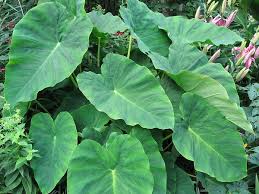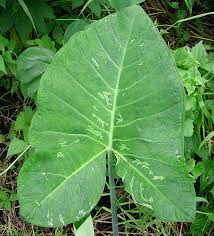Cocoyam Leaf veins, also known as taro leaves or dasheen leaves, have distinct veins that are an important characteristic of the plant. The veins in cocoyam leaves are prominent and often have a reddish or purplish hue, especially on the underside of the leaf. These veins serve vital functions for the plant’s growth and nutrient transportation.
Veins in cocoyam leaves function similarly to veins in animals, transporting essential nutrients, water, and minerals throughout the leaf. The network of veins ensures that these vital substances are distributed to all parts of the leaf, supporting photosynthesis and overall plant health. The veins provide structural support to the leaf, helping it maintain its shape and structure. They act like a framework, giving the leaf rigidity and preventing it from collapsing or wilting easily.
Cocoyam leaves contain chlorophyll, the green pigment essential for photosynthesis. The veins distribute water, nutrients, and carbon dioxide to the chlorophyll-containing cells, enabling the process of photosynthesis, where the plant converts light energy into chemical energy. Veins also play a role in the storage of nutrients. They transport nutrients from the roots to the leaves for immediate use and can store excess nutrients for future growth and development.
Understanding the anatomy and function of the veins in cocoyam leaves is crucial for effective cultivation and optimal agricultural practices. Proper care and management of cocoyam plants, including attention to their leaves and veins, contribute to healthy growth and a good harvest.
The Economic Importance and Uses of Cocoyam Leaf veins

Cocoyam, also known as taro or colocasia, is a tropical root vegetable known for its edible tubers and leaves. The leaves of the cocoyam plant have economic importance and various uses, including culinary, medicinal, and environmental applications.
Here are the economic importance and uses of cocoyam leaf veins:
1. Culinary Uses: Cocoyam leaf veins are used in traditional and modern cuisine in many cultures. The leaves are rich in nutrients and are often used to prepare various dishes, including soups, stews, sauces, and salads. The veins contribute to the texture and nutritional content of the dish.
2. Nutritional Value: The veins of cocoyam leaves are a good source of essential nutrients, including vitamins, minerals, and dietary fiber. They provide vitamins A, C, and K, which are vital for vision, immune system function, and blood clotting, respectively. Additionally, cocoyam leaves contain minerals like iron, calcium, and potassium.
3. Health Benefits: Cocoyam leaves are known for their health-promoting properties. The veins, like the rest of the leaf, are rich in antioxidants that help fight free radicals in the body, reducing the risk of chronic diseases. The fiber content aids in digestion and promotes a healthy digestive system.
4. Animal Feed: Cocoyam leaf veins, along with the rest of the plant, are used as fodder for livestock. Livestock such as goats, cows, and pigs can consume cocoyam leaves, providing a nutritious source of feed. This use supports animal husbandry and helps improve livestock health and productivity.
5. Biodegradable Packaging and Products: Cocoyam leaf veins can be used to create biodegradable packaging materials and products. The natural fibers within the veins can be processed to create sustainable and eco-friendly packaging options for various products, reducing the environmental impact of conventional packaging materials.
6. Traditional Medicine: In traditional medicine, cocoyam leaves and their veins are sometimes used for their medicinal properties. They are believed to have healing properties and are used in poultices and infusions to treat ailments like wounds, skin conditions, and gastrointestinal issues.
7. Soil Improvement: Cocoyam leaves, including the veins, can be used as organic matter for composting or mulching. When incorporated into the soil, they enhance soil structure, fertility, and moisture retention. This improves overall soil health and supports better crop growth and productivity.
Read Also: 23 Medicinal Health Benefits Of Daphne Plant (Daphne)
8. Phytoremediation: Cocoyam plants, including their leaves and veins, can be used for phytoremediation—a process where plants are used to remove, stabilize, or degrade pollutants from the soil or water. Cocoyam plants can help cleanse contaminated soils by absorbing and accumulating heavy metals or other pollutants.
The Products and By-products That Can Be Derived From Cocoyam Leaf veins
Cocoyam leaf veins, like those of other leafy greens, can be utilized to derive various products and by-products. Cocoyam leaves are a good source of essential nutrients, and utilizing their veins can reduce waste and maximize the utilization of the entire plant.
Here are some potential products and by-products that can be derived from cocoyam leaf veins:
1. Vegetable Powder or Flour: Cocoyam leaf veins can be dried and ground into a fine powder, which can be used as a nutritious supplement or ingredient in various food products such as soups, stews, and baked goods.
2. Vegetable Extracts: The veins can be used to extract valuable compounds such as antioxidants, phytochemicals, and dietary fiber. These extracts can be used in the pharmaceutical, cosmetic, or food industries.
3. Livestock Feed: Dried and ground cocoyam leaf veins can be incorporated into animal feed formulations to enhance the nutritional value of the feed, providing essential nutrients to livestock.
4. Compost and Fertilizer: Cocoyam leaf veins can be composted to create organic fertilizer. Composting helps in enriching the soil with nutrients and improving soil structure, promoting healthier plant growth.
5. Biogas Production: Cocoyam leaf veins can be used as a substrate for biogas production through anaerobic digestion. This process can yield biogas, which is a renewable energy source.
6. Animal Bedding: The dried veins can be used as bedding material for animals, particularly in livestock farming, providing a comfortable and absorbent surface for the animals.
7. Culinary Applications: The veins can be used in culinary dishes to add flavor, texture, and nutrition. They can be sautéed, stir-fried, or added to soups and stews.
8. Animal Consumption: In some cultures, cocoyam leaf veins are consumed directly, either raw or cooked, as a part of traditional diets.
9. Biochar: Cocoyam leaf veins can be converted into biochar through a process of pyrolysis. Biochar can be used as a soil amendment to enhance soil fertility and sequester carbon.
10. Dye or Colorant: Extracts from cocoyam leaf veins can be used as a natural dye or colorant for fabrics or food products.
In conclusion, these products and by-products offer various potential uses and applications, contributing to sustainable utilization and minimizing waste in the agricultural and food sectors.
Read Also: What Are the Benefits of Growing Jasmine Flowers?

